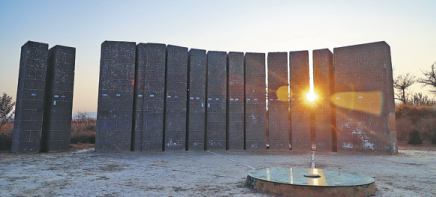Secrets of the zodiac unearthed in village

Replicas of compressed earth columns are erected at the Taosi site to measure the angle of the sunlight. [Photo by Jiao Yulong for China Daily]
The establishment of 24 zodiac terms is believed to be an outstanding contribution to the world made by ancient Chinese almanac scientists.
The system of the zodiac, used by Chinese people in both ancient and modern times, was recognized as an intangible cultural heritage item by UNESCO in 2016.
An archaeological discovery in Taosi village in Xiangfen county, Shanxi province, proved that the system was in place some 4,000 years ago.
"Excavation of the Taosi site started in the 1950s and the process has lasted more than 60 years to today," said Gao Jiangtao, one of the archaeologists who joined the excavation and research three decades ago.
Gao said one of the important discoveries were 13 compressed earth columns.
"We didn't know the function of the columns at the beginning," Gao said. "However, after years of observation of the columns' projection under the sun, we realized this was the site of an ancient observatory, with the columns used to measure the sun's beam angle and determine the 24 zodiac terms of a year."
The 24 zodiac terms are still used to guide agricultural production in China, Gao said.
The Taosi site covers an area of about 4 square kilometers, with about 2.8 sq km devoted to an ancient city.
In addition to the 13 columns, ancient sun beam observation devices like gui and biao were discovered at the site.
Another milestone discovery were the pottery relics with pictographs. Archaeologists believe these were an ancient writing system more than 500 years older than the oracles written on bones and turtle shells discovered in Anyang city, Henan province.
Taosi is now a major destination for historical and cultural exploration tours in Shanxi province.
Cui Yongwang, a resident from Taiyuan, is a regular visitor to Taosi. He paid his most recent visit on Dec 21, the winter solstice. This date features the shortest daylight hours of a year as the sunbeam angle is the smallest.
"We observed the columns' projection with reference to the sun that day and attended a lecture given by archaeologists," Cui said.
Gao was one of the lecturers at the event. He assured guests that every time they visit the site there will be new discoveries.
"Only 0.5 percent of the site has been excavated and research on the site can last many decades," Gao said.
Li Yali contributed to this story.



